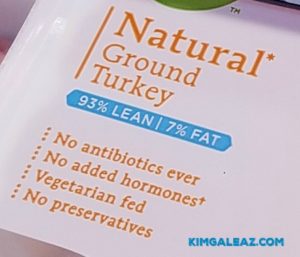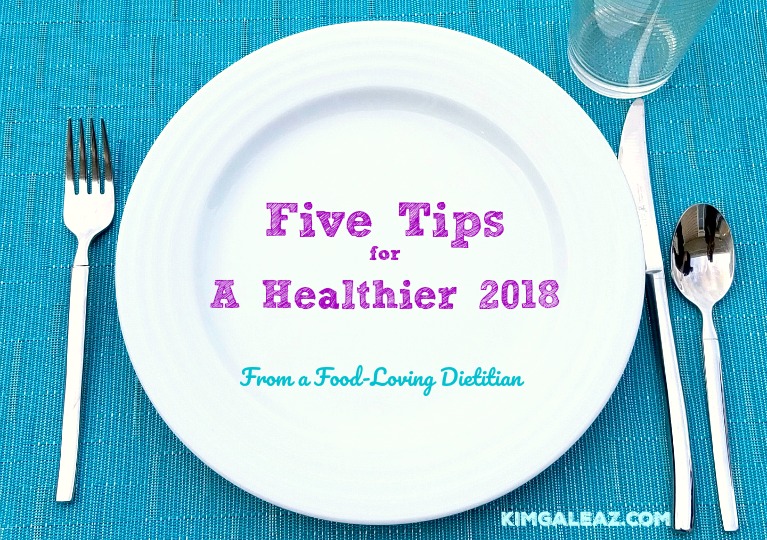Remember those New Year’s resolutions you made a couple weeks ago to eat healthier and exercise more? Well it’s NEVER too late to start, especially if you have a food-loving dietitian on your side, cheering you along with small, sensible steps. I’m all about realistic, not radical, ways to eat smarter and add activity. Here are my five favorite tips to help you create lifelong healthy habits.
#1. Eat more protein at breakfast.
More protein means more fullness, or satiety. And more fullness means you’re less likely to mindlessly munch and overeat all day long. Sure, you can aim for 20 to 30 grams protein at breakfast, which may provide maximum benefits (including maintaining muscle mass as you lose weight), but it’s so much easier to “just add more.” Add a slice of the two lean breakfast meats – ham and Canadian bacon – to that English muffin or bagel. Make oatmeal with milk instead of water. Choose Greek, rather than regular, yogurt. Slather toast with peanut or almond butter instead of just butter. Have a glass of milk with pancakes.
One of my favorite breakfasts that provides maximum satiety is two eggs scrambled or microwaved with a splash of milk, frozen green peas and a glass of 100% juice like cherry, grapefruit or orange. Sometimes I top those eggs with a little cottage cheese for an additional protein boost.

Boost breakfast protein with naturally lean Canadian bacon.
#2. Move more.
The more you move, the more calories you burn. This will likely help with weight loss and weight maintenance, but being more active provides so many other health-boosting benefits: vibrant aging, better sleep, enhanced mood and self-esteem, reduced blood pressure and cholesterol levels and reduced risk of many diseases. So whether you call it moving more, getting more activity or even exercising, just get your body moving! You already know some practical, sensible ways to do that. Steps instead of elevator. Park way in the back in parking lots. Walk around the grocery store three times before you start shopping. Dance to your favorite music in your living room. Don’t just stand there, do jumping jacks, arm circles or squats. Vacuum vigorously. Go bowling as a family.
Sure, you can aim for the recommended 150 minutes a week (5 days x 30 minutes per day) or you can just “get moving.” I love boxing classes 2 or 3 times a week, and doing the elliptical and weight-training at the YMCA. Weather permitting, I love to power walk. But when time is short, if all I can get is 15 minutes, I do it. Rather than ditch activity altogether in these cases, I simply call it my “psycho” walk or workout – shortened activity that keeps me on track, committed to a healthier life.

Find YOUR favorite activity and move more for optimal health.
#3. Focus on fruits and vegetables at every meal.
Not just lunch and dinner, but breakfast, too. Add onions, bell peppers, broccoli and spinach to scrambled eggs or a breakfast burrito. Throw dried cherries or dates in oatmeal. Microwave favorite frozen vegetables for lunch. Eat more hummus, because hummus counts as a vegetable (it’s made with chickpeas.) Double points for eating that hummus with carrots, celery and bell pepper strips. Drink tomato juice for a quick snack.
But by far the easiest way to eat more fruits and vegetables is to regularly choose all forms, not just fresh. Frozen, canned, dried and 100% juice as just as nutrient-rich as fresh and often more convenient for your on-the-go lifestyle. So 100% fruit and vegetable juices, dried fruits and vegetables, canned fruits in 100% fruit juice or light syrup, canned vegetables (rinse and drain to get rid of 45% of the sodium!) and frozen fruits and vegetables all give you great nutrition. Oh and bonus for our planet and your budget: typically less food waste with frozen, canned, dried and 100% juices!

Vegetables at breakfast?! My favorite frozen green peas with eggs and 100% tart cherry juice.
#4. Sit down and savor.
Eating and mealtime is the one time I want you to sit. Because when you sit and enjoy your food – you know, actually chew it slowly, taste and savor it – you’re eating more mindfully. And more mindful eating typically means better control of overall calories. (There’s that weight control thing again.) Food may be fuel, but it’s also a great source of enjoyment and pleasure.
And here’s another thought about enjoying your food. I want you to ditch the food fights and struggles. Give yourself permission to eat what you love. Nothing is off limits, all foods can be part of a healthy eating plan and treats are okay. They’re treats to be “included,” just not “instead of” all the nutrient-rich foods. Plan your portion. Be sensible and smart. And yes, those are sprinkles on my grandson’s 100% whole wheat bagel for “extra power” along with his favorite eggs, peas and milk.

Sit down to eat. And savor the sprinkles.
#5. Shop with confidence.
It’s okay to ignore and bypass products with fear-mongering labels like non-GMO, organic, no antibiotics or hormones and even no preservatives or additives. These terms are based on misinformation and emotion, not accurate science. Basic foods without these terms are just as nutrient-rich, safe and typically more affordable. So feel comfortable and confident with choices in your supermarket cart.

No added hormones terminology is pure fear-based marketing. Hormone use is illegal in poultry and pork.
Just like I’m here to help you with food nutrition concerns, farmers can help you better understand how their livestock is raised and crops are grown safely and sustainably. So don’t hesitate to ask.
Cheers to a happy, healthy and active 2018!
Disclosure: As a proud supporter of Indiana Agriculture and Farmers, I’m happy to say this is a sponsored post for The Glass Barn, brought to you by Indiana Soybean Checkoff dollars. All content is created solely by me and all opinions are mine. The Glass Barn is a physical and online resource providing educational materials on Indiana farming to educators and students. You can visit the Glass Barn at the Indiana State Fairgrounds.
